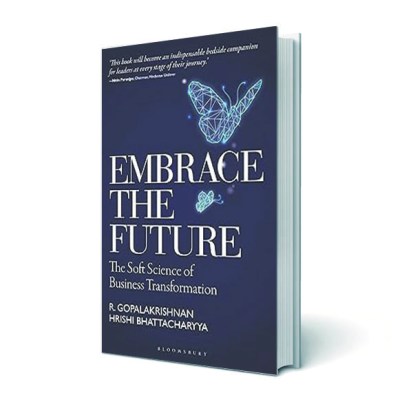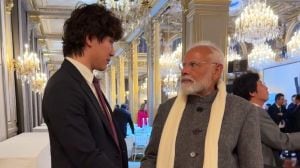By Shivaji Dasgupta
You can consider it to be a stimulating jugalbandi or a Grand Slam doubles pairing, depending on your affections. Either way, Embrace the Future delightfully blends strategic constructs with compelling cases, in a charmingly simple construct.
At the centre of the argument is the collaboration of heart and mind in the craft of business transformation. Which once upon a time was a matter of choice and ambition, but now is perhaps an operating imperative in the Shikansen evolving world. Exactly why Gopalakrishnan and Bhattacharyya’s effort is relevant even for routine management, and not just the strategic honchos.
In its introduction, a fine reference is made to the Vanderbilt business empire, and indeed its dissolution. While one part was due to profligate excesses of the heirs, the significant other was about obsolescence of the core business model due to resistance for transformation. The authors refer seamlessly to Indian scenarios in a contradictorily positive context, special reference to the Brooke Bond Lipton union and the larger universe of HUL and Tata wonders.

Equally aptly, the anecdotal contexts of how Hindi became the de facto national language is insightfully narrated—the domineering diktats failed while the soft power of Bollywood melted the barriers. Heart and mind in active collusion, as in the instance of family planning campaigns. Quite enjoyable is the reference to ‘obsolete your own product’, a credo of the Cummins Energy Group of then, and so wonderfully necessary in these times.
The first part of the book, curated by Gopalakrishnan, focuses on the heart in ample abundance. A sobering yet inspiring context is the Tata Steel (then TISCO) restructuring under Dr JJ Irani in the late 1980s, wherein the workforce was pruned from 80,000 to 40,000. An otherwise heartbreaking process, it was rescued effectively by transparent and sincere communication, in tune with tangible compensation, in clear contradiction to the Hershey’s encore, which had to be withdrawn due to pressure from insecure workers.
Rather apt is the validation of ‘intellectual nomads’ as necessary ammunition for successful transformation, the openness to influence a desirable sauce. ‘Othering’, the unavoidable tendency of faux empathy, is brought to life by Nelson Mandela’s presence in the Springboks match of 1995, a sternly all-white domain broken effortlessly by the leitmotif of the Rainbow Republic.
In the narrative at large, many easy to manage strategic constructs are brought to play and they are best enjoyed in self discovery mode. Yet another lovable adhesive is the cross referencing socio-political scenarios, so delightfully real— the Gandhian evolution from the Savile Row suited South African lawyer and Lal Bahadur Shastri’s empathetic championing of Operation Flood, Dr Kurien’s Amul. The Saudi Arabian anecdotes confirm both the sameness and uniqueness of the human race, as patterns are thoughtfully established.
As understandable, the Tatas occupy pole position in Gopalakrishnan’s tales, from the sale of TOMCO to the Innovista movement, a journey empowered by sincere empathy. Deeply lovable is his concept of ‘demyelination’, the necessity to constantly cushion the raw nerve. The Korean idea of slowing down when you need to go farther is indeed inspiring. The same goes for the Miyawaki technique, the need to create mini forests and not mammoth growth, as a surrogate for building leadership bench strength.
Some more vital learnings follow. The trap of institutional memory which prevented Kodak from migrating to digital imaging. Thoughtless outsourcing, whether NASA or NHS, and the difference between indigenously filtered and open source unfiltered leadership to anchor transformations; Ramesh Sarin at Voltas and Lou Gerstner at IBM being two deeply relevant use cases. Every reader will take home the point that companies must live for a purpose, possess a long-term vision and imbibe the art of critical thinking. Whether ‘orbit shifting’ or ‘cyclical learning’, the choice is often circumstantial.
The second part of the book, authored by Bhattacharyya, is a soothing, strategic refresher course, embellished by deeply meaningful cases. HUL, predictably, is a prolific hub of the narrative and the riveting history of dedicated distributor networks and the incubation of Rin detergent are legacy instances of organic transformation. Equally sobering is the worldview on research, as the author seeks to rationalise, while not dismissing, the acumen of the past and present to influence the swashbuckling future.
A whole host of fundamental strategic constructs are beautifully clarified and that too with actionable toolkits. The twin cities of cost leadership and differentiation, occasionally divergent and potentially converging. Benchmarking as SOP and war games as turbine fuel. Truthfully, the cases in terms of urbanisation, mobile telephony and energy will not be new news for involved readers, but they surely pass the verification test.
Perhaps the most scalable foundation of this section is the triumvirate of core purpose, targeted future and strategy. Also the adjunct four-pronged screenplay of which customers to target, which playing field, the products or services and the secret sauce of delivery and triumph. There are two wonderfully crafted real estate case studies, mutually exclusive yet exhaustive in a seemingly unilateral category. Bolstered further by learned narratives on Fair and Lovely (now defunct) at the launch stage, Ikea, Nirma and the Apple crisis before Jobs came back to stage a turnaround. Those with a penchant for history will love the black cabs versus Uber London Transportation Derby and its evocative strategic decoding.
In sum, true to its deliberate duality in authorship, The Soft Science of Business Transformation is an unusual inspiration by Indian standards most definitely. The gravitas of their experience is gratefully the source code for simplification and thus easy absorption for every motivated reader. Which, truthfully, must include you, me and every candidate sincerely interested in the development of self and society. The authors conclude by stating that excellence is never an accident, indeed an outcome of “high intention, sincere effort, and intelligent execution”. It must be said that this book lives up to this promise.
The author is an autonomous brand consultant and writer
The Soft Science of Business TransformationR Gopalakrishnan & Hrishi BhattacharyyaBloomsburyPp 240, Rs 699









